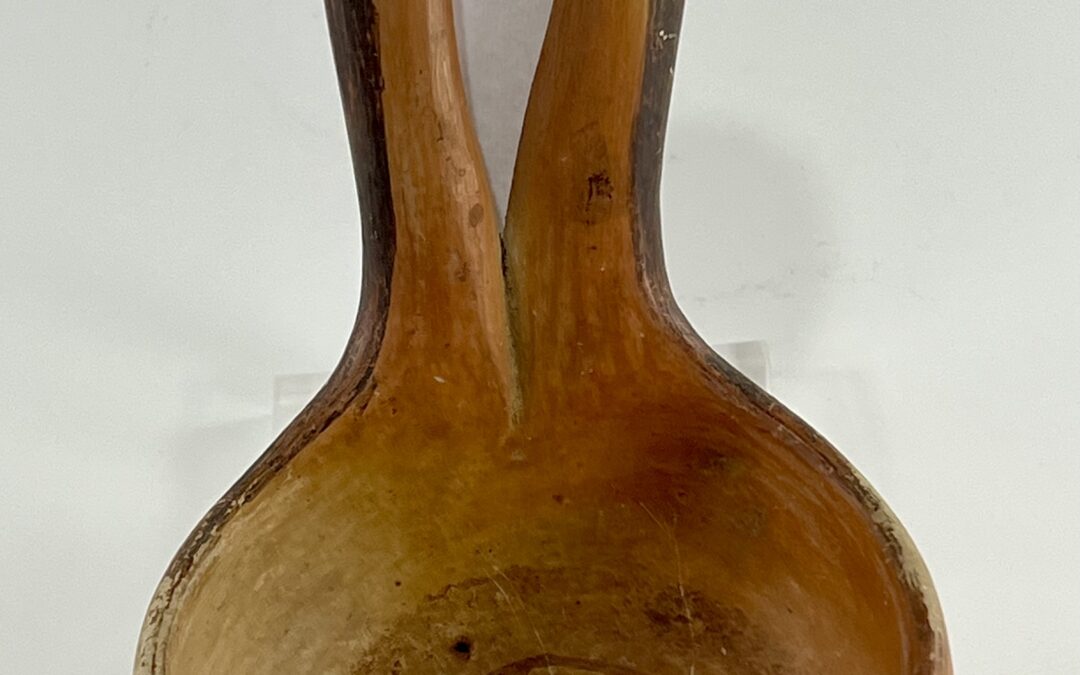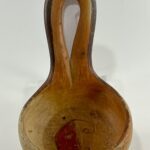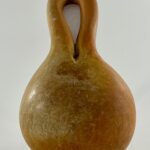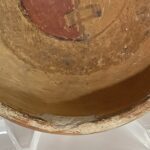- Ladle 2025-01
- The handle is 2.125” wide at its widest.
- The handle is 0.6875” thick.
- The bowl is 0.25” thick.
- The bowl is 1.875” deep.
Small and worn, this ladle displays an image of the Creator Tawa. This image has a history, both at Hopi and in this collection:
- In 1896 J. Walter Fewkes excavated a Hopi ancestral site he called “Old Cunopavi” and found a bowl with this Tawa image.
- That same year (1896) Nampeyo used a version of this design on one of her bowls that was purchased by the Smithsonian Museum.
- About that same year (1896) or shortly thereafter ladle 2025-01 was made, apparently by a woman who saw the bowl excavated by Fewkes or a drawing of the bowl and she reproduced the design exactly.
- In the late 1960’s or early 1970’s Jean Sahmie used this same image on a bowl she formed, changing only the color of one panel (2023-13).
Photographs of all of these pots can be found in the catalog entry for Jean’s bowl (2023-13).
Form:
Six-and-a-half inches long, the ladle is not very big, but the thickness of its handle gives its substantial heft, weighting in at about a pound. Though less than the handle, the thickness of the bowl is still substantial. The handle was made from a coil of clay shaped to leave the tear-drop opening. Note that on both sides of the handle a 1.25-inches groove in the clay extends the point of this open tear-drop form. On the top-side of the handle, at the end of this grove, the thickness of the handle decreases dramatically as the bowl joins the ladle. The ladle was slipped with a clay that fired a dark orange on the handle and much of the exterior of the bowl. The slip on the interior of the bowl and part of the exterior is a much lighter orange.
The front lip of the bowl is chipped, with a particularly large chip missing from its interior. Below this edge the exterior walls of the bowl are vertical for about 1.25-inches and then curve 2.25-inches to the bowl’s bottom. As the slope of the walls changes below the lip, the surface of the slip has been worn away, revealing a lighter-color clay beneath.
Design:
The edge of the handle and the edge of the bowl were painted with a black stripe, thick along the edge of the handle and thin on the edge of the bowl. This black edge is clearly visible on the handle and on the first 1.375-inches of the bowl rim on either side of the handle. Between the 5 o’clock and 10 o’clock positions on the rim this black edge has been largely worn away.
The interior of the bowl is 4.0-inches wide. At the center of the interior is a design consisting of two circular elements, 3.0 and 1.875-inches wide. Thus the gap between them is 0.5625-inches wide and is painted with a light grey-tan thin paint. Embedded in this band are mostly small dark points of black paint. The washed out grey-tan color and the small size of most of the darker dots have the effect of making this band of color indistinct.
The pattern within the smaller, central circle is much clearer, though this design is also worn. The circle is bifurcated by a thin black line, the section to the viewer’s right right either unpainted or painted a light yellow: the color is unclear. The left section is painted a dark red.
The left eye is an unpainted rectangle with a black border, though a careful look with a magnifying glass shows a tiny horizontal line in the center of the space. This format is the same as used by Nampeyo in her version of the design, but is different than the format on the ancient bowl with this design and different than Jean Sahme’s rendition. (See 2023-13 for four versions of this design.) The tadpole shape of the right eye is larger than the left eye. The mouth is an unpainted rectangle, with more than half of its length in the right, unpainted, side of the face. It appears that there is an extension of the mouth on its right edge, a tiny lightly-painted square set above another tiny black square.
Design Analysis:
The form of ladle 2025-01 indicates a master potter. The thick 0.6875-inch handle handle provides a solid holding surface. As it transforms into the bowl it loses 63% of its thickness, but the boundary between handle and bowl is smooth and seamless. Because of the tear-drop shape of the opening of the handle, the visual weight of the ladle is lighter than its actual weight. The shape of handle is elegant. The carefully delineated groves in clay extend the point of the opening and thus unify space and form. The tear-drop opening interacts with the circular rim of the bowl to create an interesting visual contrast.
It is amazing how consistent small details are between three version of the design painted in the 1500’s, about 1896 and about 1975. [See bowl 2023-13 for photographs.] On these three pots, the elements of design are exactly the same. Most striking is a minor detail: the offset of the rectangular mouth to the viewer’s right. The imbalance of the mouth and the strikingly-different form of the eyes throw Tawa’s face off balance and give it an unexpected energy for so simple a design. The right-edge extension of the mouth on ladle 2025-01 serves to further imbalance the symmetry of the design and increase its energy.
The 1) worn Tawa design, 2) worn black paint on the edge of the bowl, 3) the wear and large interior chip of the front lip, and 4) the wearing away of the slip on the exterior below the front lip are all evidence of ethnographic use. The 5 o’clock to 10 o’clock wear on the rim suggests the person who used the ladle was left-handed.
I sent photographs of the ladle to author and Hopi pottery expert Ed Wade and his response reinforces my understanding of the ladle and adds some context:
“Quite wonderful piece. Considering the composition of the bifurcated central face I would place it around the end of the 19th century to beginning of the 20th. The form of face was seen within ancient petroglyphs and then again on certain sikyatki ceramics. Been much debate about its depiction with one argument suggesting the dual aspect of Tawa (sun) and moon (Kokosori).
The wear on the ladle derives from native use particularly on the frontal terminus with the large chip from the object being bumped inside of a jar or deep bowl. Very well made.
–Dr Edwin Wade, email 2-16-25”
In my Western culture, we distinguish between ordinary objects and “art.” In many tribal societies, from Africa to Native American, all objects have spirit and thus beauty. Ladle 2025-01 is a good representation of this Native belief. With care taken both in its form and painting, this simple object is both useful and beautiful. Before I begin a meal I give thanks for the bounty in my life. I suspect this elegant ladle carrying the image of Tawa the Creator served the same function as it served food from a cooking pot. Its form and sacred image have existed at Hopi for more than half a millennium, a measure of the persistence of faith, culture and design.





